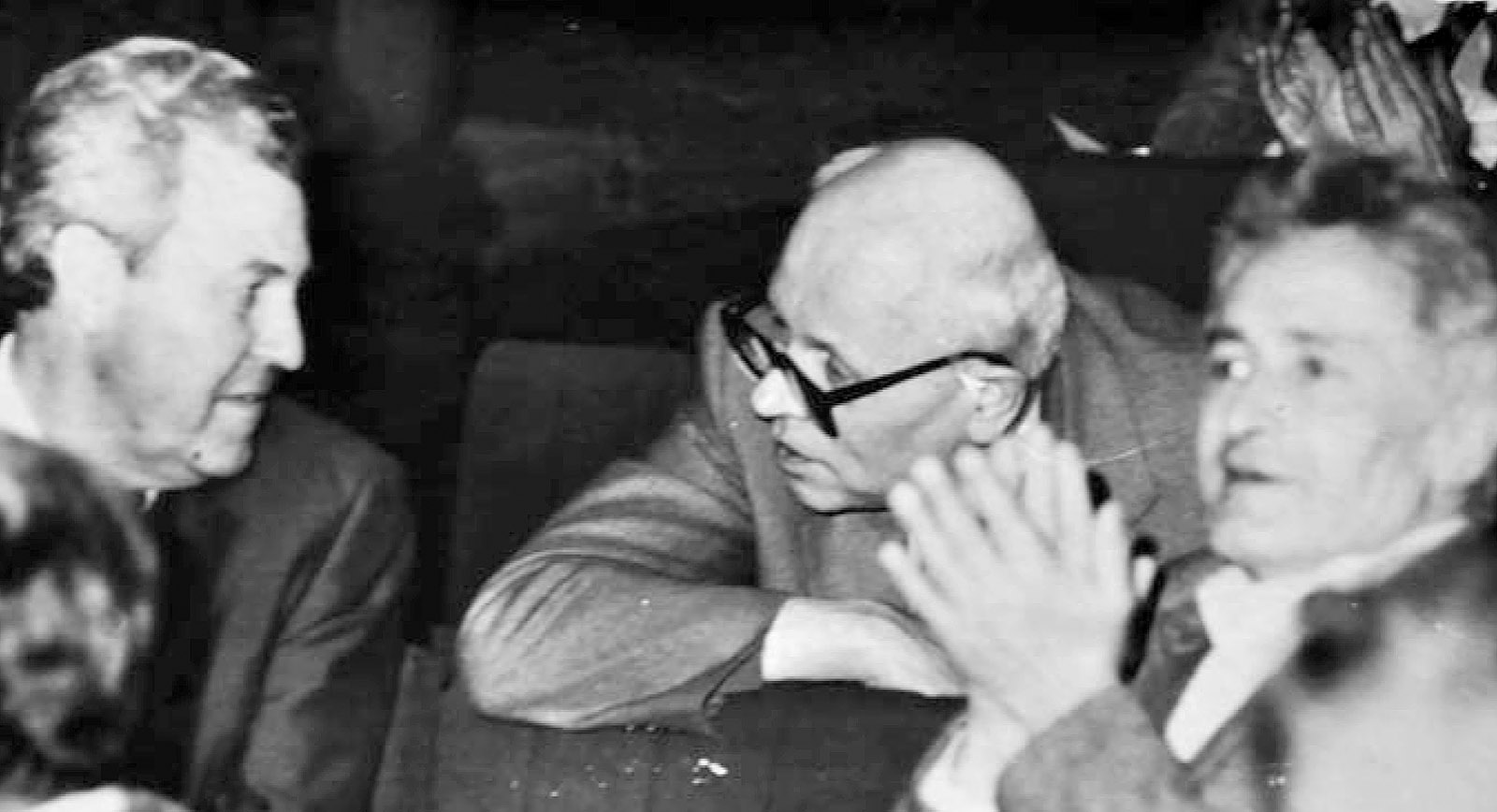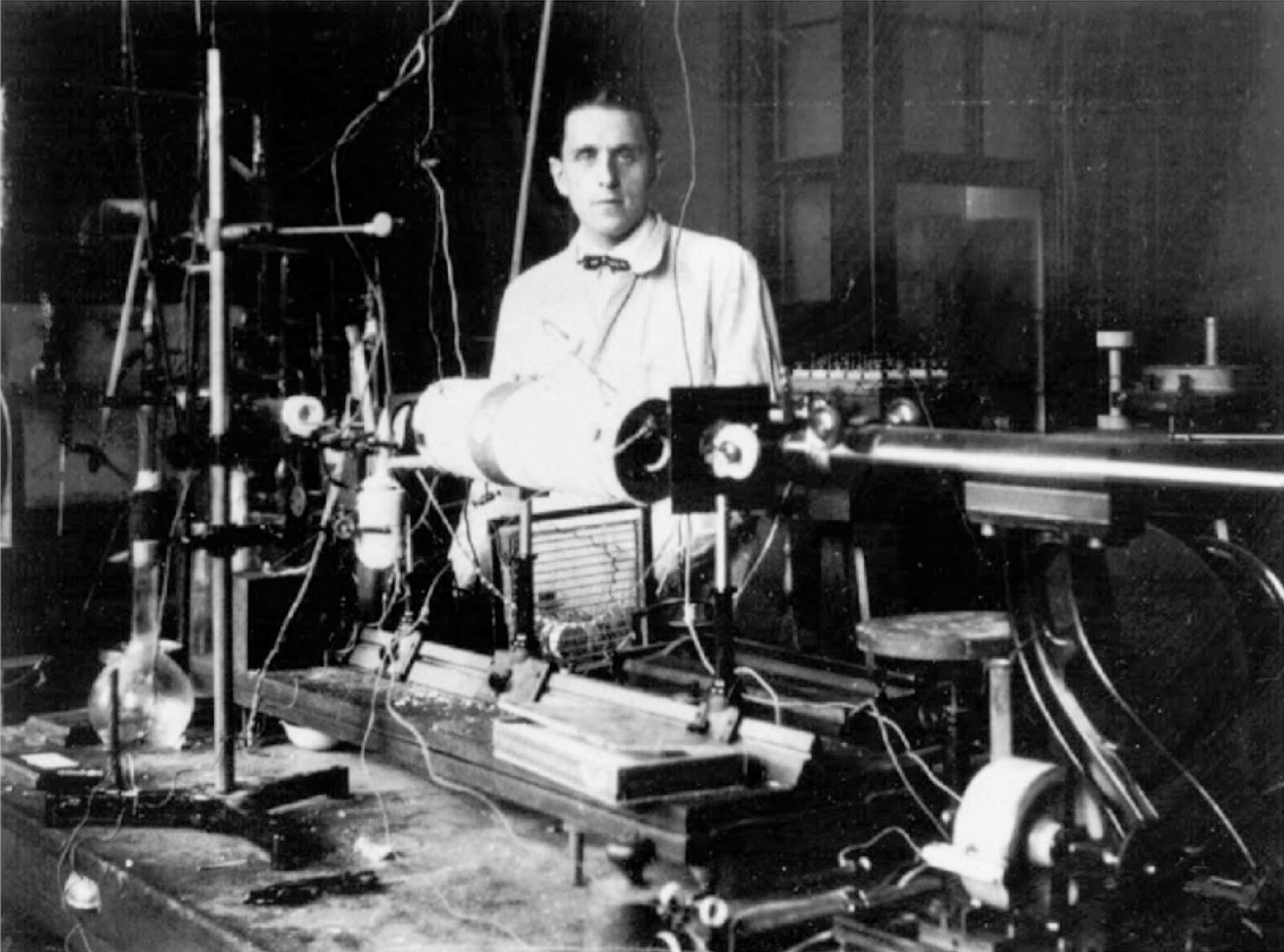In the 1930s German and Russian scientists of Jewish origin were treated quite differently. The German scientists were automatically “guilty” if they had more than one eighth Jewish “blood.” In Russia they had to be guilty of doing something. Until October 1941 Jews were encouraged to leave Germany and most of the prominent scientists did so, though not without great difficulty, since they were allowed to take very little money out of the country. The Russian scientists, on the other hand, were not allowed to leave. Many were arrested and forced to “confess” to crimes. After having done so they were either imprisoned or summarily executed. In both cases the amount of scientific talent destroyed was beyond calculation. Here are two examples from German science.
Herman Mark was born in Vienna in 1895, making him an Austrian citizen. His father had been born Jewish but converted to Lutheranism upon marriage. A highly decorated World War I veteran, Mark became a very distinguished polymer chemist and was at the IG Farben company in Germany until the Nazis came to power in 1933, when he returned with his family to Vienna. But after the German annexation of Austria in 1938 he was arrested by the Gestapo. He was released without his passport, which he retrieved with a bribe of almost a year’s salary. He then left on a “ski trip” to Switzerland with his family, in a car with skis on the roof and a Nazi flag on the hood. He had bought some $50,000 worth of platinum wire that he fashioned into coat hangers. His wife had knitted covers for them. He ended up at the Polytechnic Institute in Brooklyn, where he assembled a noted group of chemists. His son Hans, who was on this “ski trip,” became a physicist and served as the secretary of the US Air Force.
The nuclear physicist Hans Bethe is another example. He had two Jewish grandparents, so according to the first racial laws that were promulgated in 1933 he could not hold a university position. He was at the time at the University of Tübingen and was immediately dismissed. His former professor Arnold Sommerfeld—a very great teacher of physics—made strong efforts to find jobs abroad for his Jewish students. Bethe found a temporary job in Manchester and then got an offer from Cornell, where he spent the rest of his career. He won the Nobel Prize in 1967. During the war he was head of the Theoretical Division at Los Alamos. Late in his life he said he regretted that the Manhattan Project had not made the bomb earlier so that it could have been used against Germany.
Much has been written about the fate of Jewish scientists in Soviet Russia, but I have never seen anything quite like Physics in a Mad World. It consists of two long essays on the physicists Friedrich Houtermans and Yuri Golfand. Both of these are written by Russians who had access to police files. The book’s editor, Mikhail Shifman, now a professor at the University of Minnesota and a distinguished theoretical physicist, was also born in Soviet Latvia. He supplies useful comments. The essay on Houtermans by Viktor Frenkel, which takes up much the largest portion of the book, is particularly remarkable, but Golfand also deserves close attention.
Golfand was born in 1922 in Kharkov in Ukraine. His father was a nonobservant Jew who was an engineer in the meat business. Yuri showed mathematical ability at a young age. In 1939 he became a student at Kharkov University and was then sent to the Air Force Engineering Academy, where he reluctantly became a military engineer, which saved him from going to the front. After the war there was an outburst of anti-Semitism, so he could not get into any university to study for a graduate degree. He worked in the Moscow Computing Center and started graduate school by correspondence.
Much later, after receiving a master’s degree by correspondence, he managed to get a job at the prestigious Physical Institute of the Academy of Sciences (FIAN) in Moscow. One of the groups there worked on the design of the Russian hydrogen bomb. Golfand did computations for the construction of the bomb without knowing what they were for. Later, his experience at FIAN made it difficult for him to leave Russia because it was claimed that he knew military secrets. He became what was known as a “refusenik” since he was denied an exit visa.
In 1971 Golfand and an assistant published a paper on “supersymmetry” that became one of the cornerstones of modern elementary particle theory. In nature there are two classes of particles—bosons and fermions. An example of the former is the Higgs boson and of the latter the neutrino. Supersymmetry relates the two classes and predicts that for every boson there is an as yet undiscovered fermion and vice versa. If this turns out to be true, then it would help to explain why the various forces are conjoined in a unified scheme. Golfand was one of the first to suggest this idea. The Large Hadron Collider, built by the European Organization for Nuclear Research near Geneva, is trying to produce these particles.
Advertisement
In 1972 Golfand lost his job at FIAN because he was Jewish. He began trying to emigrate to Israel in 1973 but it took him seventeen years to get permission to leave. He was “invited” by the KGB to visit its headquarters on several occasions and always refused to show up. The miracle is that he was never thrown in jail and somehow kept working at home. His wife took menial jobs to support them. He was eventually offered an academic job in Russia in 1980 but he wanted to get out. He finished his career at the Technion in Israel and died there at the age of seventy-two. In view of what he did manage to accomplish under extremely difficult circumstances, one wonders what he could have achieved if he had been allowed to flourish in the Soviet Union.
Over the years I have read bits and pieces about Friedrich Houtermans but nothing like what is in Physics in a Mad World. The long profile was written by Victor Frenkel, a noted biographer and historian of Soviet science who died in 1997. Shifman has filled in the gaps. If there were a movie of Houtermans’s life, no one would believe it.
Houtermans was born in 1903, in Zoppot near Danzig. His mother was a Viennese, half Jewish, and the first woman in Vienna to receive a doctorate in biology. His father was Dutch and quite well to do. When Houtermans was three his parents divorced, and he moved to Vienna with his mother, who became a prominent cultural figure there. She decided that young Houtermans could use some psychiatric counseling so she engaged Freud, who told him to leave after it became clear that Houtermans was making up his dreams.
Houtermans attended a prestigious gymnasium and excelled in mathematics. He also became interested in The Communist Manifesto, which he read aloud to his classmates—something his teachers did not appreciate. In 1922 he enrolled in the University of Göttingen, one of the greatest centers for physics and mathematics in the world. A few years later he wrote his Ph.D. thesis there.
Another student at Göttingen was Robert Oppenheimer. On a train trip—a visit to Hamburg—all the students except Oppenheimer had extremely shabby luggage. The one woman in the group, Charlotte Riefenstal (no relation to Leni), admired Oppenheimer’s pigskin suitcase. Sometime later Oppenheimer appeared at her doorstep with it and in a gesture of courtship gave it to her. She kept the suitcase but married Houtermans, becoming his first and then third wife. He moved on to Berlin where he made a very important contribution to astrophysics with the British astronomer Robert Atkinson. This was based on work he had done before he moved to Berlin with the Russian physicist George Gamow, whom he had met in Göttingen.
Göttingen was one of the centers for the development of the then new quantum mechanics. Max Born was an immensely respected senior professor. His assistant Werner Heisenberg invented a version called “matrix mechanics.” Heisenberg did not know what a matrix was until Born explained to him that he had in fact created one. Heisenberg found that in his expressions the quantities did not obey the normal laws of arithmetic. For example AB was not equal to BA. He just accepted this without knowing what it meant. Born realized that it meant that A and B were matrices—arrays of numbers—and that these matrices do not necessarily obey the AB=BA rule. Thus a form of quantum mechanics was created that involved matrices. In the meantime, Schrödinger found another form that involved ordinary equations. It was soon realized that these were simply different expressions of the underlying theory.
Gamow made one of the first applications of quantum mechanics to nuclear physics. Some nuclei decay into so-called alpha particles, which are actually helium nuclei. These nuclei have a positive charge so it was not clear how they escape from the mother nucleus, which has a positively charged barrier. Classical physics said this was impossible because the nucleus, it was thought, would repel the alpha particle and it could never get out, but in quantum mechanics the alpha particles can tunnel through the barrier. This is what Gamow worked out.
He and Houtermans wrote a paper on some of these processes. When Houtermans moved to Berlin, he and Atkinson considered the possibility that the barrier could be penetrated from the outside so that two light nuclei could fuse. Because of the difference in the masses of the two nuclei, energy is produced. They realized that the conditions in stars—including the sun—are such that fusion can take place and that this can account for stellar energy. This is probably the most important contribution Houtermans made to physics, but he made many others.
Advertisement

In the 1920s Houtermans joined the German Communist Party. This, along with his Jewishness, meant that he had to get out of Germany in the 1930s. He and Charlotte first went to England, where he did research for the EMI Television Laboratory. In 1935, he chose to go east rather than west, which nearly cost him his life. He joined the Ukrainian Physico-Technical Institute in Kharkov, where he had excellent colleagues. By 1937 an official Soviet declaration stated that “enemies [had] penetrated among the physicists, carrying out espionage and sabotage assignments in our research institutions,” and that it was the duty of physicists to unite “around our great leader Comrade Stalin.” From that point on, it was only a matter of time before Houtermans would be arrested. This happened in the first few days of December 1937 in Moscow.
Physics in a Mad World provides the details of his interrogation by the KGB. For days on end he was kept awake and standing. If he fell asleep he was doused with ice water. His feet swelled to the point where he could no longer wear his shoes. He was finally broken when he was told that his wife was going to be arrested, that his children were going to be put in an orphanage under new names, and that he would never see them again. Actually Charlotte and the children had already escaped from Russia. There is a detailed description in the book of how they did this, partly with the help of Niels Bohr. Charlotte eventually ended up in the United States and taught at Vassar.
Houtermans knew nothing of their escape. He was put back in prison. In Shifman’s book there is a stunning description of him by a fellow prisoner, Konstantin Shteppa, professor of history at the University of Kiev. Shteppa had just entered Houtermans’s cell:
I entered the cell which contained a single piece of furniture a wooden bunk-bed. Immediately I was shocked. On the top bed laid a corpse. The man’s face was grey and the skin was so thin that one could see every bone under it. I was terrified. “Is it possible that they’ve become so cruel? That the degree of their mockery has reached the point of putting the dead and the living together?” That was my first thought after I saw his face.
After a while he opened his eyes. He stared at me with a look of expectation, hopeful I would bring him all kinds of news, which he needed so desperately.
“Are you new? I can tell by the way you walk, you move and you look,” he said in his broken Russian. He lifted himself up and offered his thin hand for a handshake. “My name is Fritz Houtermans, a German…a physicist…a former member of the communist party…former emigrant from Nazi Germany…former professor at the Institute of Physics in Kharkov…former human being—and who are you?”
Houtermans asked for cigarettes, which Shteppa did not have. Houtermans was a lifelong chain smoker and eventually died of lung cancer. He kept himself sane by doing number theory in his head. He found a proof that the equation a3+b3=c3 has no solution for nonvanishing integers. This is not trivial. The great eighteenth-century mathematician Leonhard Euler found a proof that was somewhat faulty. Houtermans describes his attempt. First he tried to use matches to write on soap, but that did not work. He writes:
When I found on August 6th an elementary proof for Fermat’s famous problem for n=3, which I have learned since is essentially the same as Euler’s, by “descent infinite,”* I got very excited about it, because I did not know Euler’s elementary proof to exist, and I applied to the People’s Commissar of the Ukraine to get paper and pencil. (I said I wanted to work out an idea of mine on a method of radioactivity which might be of economic importance.)
When my petition was not granted, I went on a hunger strike (only declining food, not water). I was alone in the cell then and succeeded in getting pencil and paper after 8 days of hunger strike, by which time I was very much weakened since I had been in a bad state when I started. I wrote a number of theorems.
Later he published some of the theorems he had written out in prison.
The Soviet–Nazi 1939 nonaggression pact changed his circumstances. There was an exchange of prisoners and Houtermans was sent to Germany, where he was immediately arrested by the Gestapo and ended up in a prison in Berlin. His cellmate was about to be released, so Houtermans wrote a brief note stating his whereabouts, which he asked to be delivered to some of his former colleagues. One of these people was Max von Laue, a Nobel Prize–winning physicist and an outspoken critic of the Nazis. It seems a miracle that he was not put in jail. Because of his prestige he not only got Houtermans out, he also found him a job.
Manfred von Ardenne was a German aristocrat who had become very wealthy because of his electronic inventions. He had an estate outside Berlin where he maintained a substantial laboratory funded by the post office. He could hire anyone he wanted, and he hired Houtermans. I have read Ardenne’s autobiography and I cannot separate fact from fiction in it. There is no question that at the time Houtermans joined the laboratory, the scientists there were doing nuclear physics. To what end is still not clear, but looked at from the outside they were certainly studying nuclear energy and its applications. There was also a rival official program that Heisenberg eventually headed and that tried to ignore von Ardenne’s laboratory.
Both the official program and von Ardenne’s laboratory hit on the idea of using element 94, which its American discoverers named plutonium, for nuclear energy—a fact that was concealed until after the war. This was Houtermans’s discovery. He was so alarmed by it that he tried to inform some of his colleagues in America. A communication from him did arrive but no one knew what to make of it. When the Russians occupied their part of Berlin they seemed to know about Ardenne’s laboratory. Ardenne went willingly to Russia and headed a laboratory there that worked on the Russian atomic bomb program. Houtermans was long gone.
His first destination was the Imperial Physical-Technical Institute in Berlin. In 1943, he took advantage of a German law to divorce Charlotte, who was still in America, on the grounds that they had not lived together for many years. He remarried and had three children with his new wife. Then he went to the United States and remarried Charlotte, whom he divorced again after two years. He soon became a professor in Bern and married again. By this time he had changed his field to earth sciences. He invented new and better ways of measuring the age of the earth. He died in Bern in 1966. His creativity under terrible circumstances was almost incredible. One can only imagine what he could have done if he had been left alone.
-
*
“Descent infinite” refers to a method of proof that proceeds as follows. First suppose that you have found three nonvanishing integers that satisfy a3+b3=c3. (If one of the integers vanishes then the solution is simply that the cube of one equals the cube of the other, which is obvious.) Suppose you can show that if this is true then there must be three smaller ones that also satisfy the equation. This part is not trivial. But then there must be three still smaller ones so there can be no smallest one, which is a nonsensical outcome. This provides a proof by contradiction. One has assumed an integer solution to the cubic equation and has shown that this leads to a nonsense. ↩



